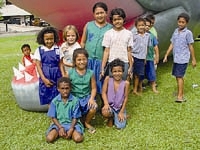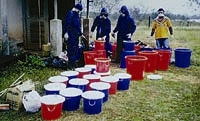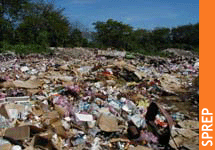







| PROGRAMMES | PROE | PUBLICATIONS, LIBRARY and IRC | SITE MAP | SPREP FORUMS | WEBMAIL - Global / Local | CONTACT | HOME
| Search |
Home > Programme > Pacific Futures
2. Pacific Futures
Goal: 
Pacific island countries and territories able to plan and respond to threats and pressures on island and ocean systems.
Programme rationale
Programme focus
- 2.1 Managing multilateral environmental agreements and regional coordination mechanisms
- 2.2. Environment monitoring and reporting
- 2.3. Climate change and atmosphere
- 2.4. Waste management and pollution control
- 2.5. Environmental planning
Programme rationale
This Programme focuses on securing a healthy Pacific islands environment for future generations. Cross-cutting themes for the Programme include good governance - through building institutional capacity for assessment and priority setting, planning responses and ability to monitor and anticipate the impact of pressures, and emerging threats to Pacific islands. In the medium term, threats and pressures include climate change, climate variability, sea-level rise, pollution, waste and other land-based sources of pollution.
Programme Focus
2.1 Managing multilateral environmental agreements and
regional coordination mechanisms
Many Pacific islands are parties to a range of international environment-related agreements and processes. To secure favourable outcomes, Pacific island countries (PICs) are required to maintain an active role in the development and subsequent implementation of these agreements and negotiation outcomes. To support SPREP members, the Secretariat will promote coordination at the national level, provide technical and legal advice to countries, assist in preparing conference briefing papers, identify synergies between agreements and related international processes such as the Convention on Sustainable Development (CSD) and the Barbados Plan of Action Ten Year Review (BPoA+10), and coordinate pre-conference consultations to determine regional positions. This component also addresses the need to strengthen regional legal frameworks such as the Apia, SPREP and Waigani Conventions.
2.2. Environment monitoring and reporting
There are two linked components to this output. Ultimately, it aims to provide PICTs with better systems to monitor environmental performance, but recognizes that the key to this is the availability of suitable information.
The lack of data vital to effective decision making has been identified as a recurring need for most PICTs since the 1992 Rio Conference. Support for data acquisition, application and management is therefore a key element of this plan's emphasis on sustainable development. Increasingly the accessibility of data relates to the capability of countries in information and communication technologies. SPREP has a contribution to make in the best knowledge management practices across the region.
The state of the environment (SOE) component of the Programme will build on the outcomes of WSSD and BPoA+10 at the national and regional levels to reassess and identify key issues for environmental management and sustainable development. The aim is to develop processes to monitor detrimental trends, emerging threats or identify competing policies, which threaten sustainable development. Simple but systematic reporting systems shall be designed with PICTs and tailored to suit key issues and indicators. The outcome of this work will be a reduced burden of reporting by PICs to numerous multilateral environmental agreements and international agreements.
2.3. Climate change and atmosphere
One of the greatest challenges to sustainable development in the 21st century is climate change. While the international community has initiated steps under the United Nations Framework Convention on Climate Change (UNFCCC) to stabilize greenhouse gases in the atmosphere and promoted carbon trading to assist with this overall objective under its Kyoto Protocol, progress has been slow.
SPREP’s members have identified four main areas of work. First, meteorological and climatological capacities of PICTs need to be strengthened to plan and respond to climate variability and extreme weather events. Second, more research needs to be undertaken to understand climate variability, climate change and sea level rise through information, modeling and clearinghouse mechanisms. Such research needs to identify and assess vulnerabilities as well as impacts. Third, Pacific Islands urgently need to adapt to climate change and adopt mitigation options and coordination, and assistance is needed to assess and implement feasible options and access funds for implementation of activities. And fourth, technical/legal advisory services need to be provided to assist Pacific Island Parties implement the UNFCCC and to ensure consistency with other international processes such as the WSSD Type II initiatives and BPoA+10. As well linkages need to be made with the CBD and related instruments such as the Convention on Desertification.
At the regional level SPREP coordinates the regional framework for climate change and its attendant round table process, and assists with mainstreaming of climate change into developmental processes and capacity building activities. Eliminating ozone-depleting substances by the year 2005 to meet the objectives of the Montreal Protocol will also be addressed under this component.
2.4. Waste management and pollution control
 Pollution
is one of the major threats to sustainable development in the Pacific
islands region. The transboundary nature of much marine pollution requires
a coordinated and comprehensive approach to both assessment and control.
Without adequate measures to combat the growing sources and extent of
pollution, the Pacific islands’ efforts to maintain healthy societies,
to stimulate development and new investment and a sustainable future
for its people may be permanently undermined.
Pollution
is one of the major threats to sustainable development in the Pacific
islands region. The transboundary nature of much marine pollution requires
a coordinated and comprehensive approach to both assessment and control.
Without adequate measures to combat the growing sources and extent of
pollution, the Pacific islands’ efforts to maintain healthy societies,
to stimulate development and new investment and a sustainable future
for its people may be permanently undermined.
Increasing quantities of solid waste, the lack of controls on chemicals imported into the region, and the lack of capacity to manage the range of pollutants are of immediate concern for Pacific island members. In addition to land-based activities, the region’s coastal and marine resources are threatened by introduced marine species, ship wrecks, marine accidents and spills, ships’ waste and antifouling paints on vessels.
The primary role of SPREP is to assist countries in implementing the Programme, mainly through technical advice and support. It is expected that the Programme will continue to evolve over time, including a continuing move to an even greater focus on national activities carried out under bilateral arrangements. There are some elements, such as hazardous waste disposal, where SPREP is directly involved in implementation, because of the technical and logistical complexities of the work.
2.5. Environmental planning
Effective and lasting integration of environment and development is at the heart of sustainable development and, in turn, island livelihoods. The intent of environmental planning is to address the causes of environmental degradation and over-exploitation through integrated government and community decision-making mechanisms.
The aim is to enhance the range of tools available to PICTs to enable sound environmental decision making in the pursuit of sustainable development. Effective decision making through planning is the primary theme. Capacity development will assist with providing development-assessment tools to anticipate and address the negative pressures, the key risks and emerging threats, and to seek out sustainable development opportunities. There will also be the promotion of integrated assessment and environmental planning platforms for PICTs - to bring together the two above aspects in a manner that mainstreams environment as part of the development process.
